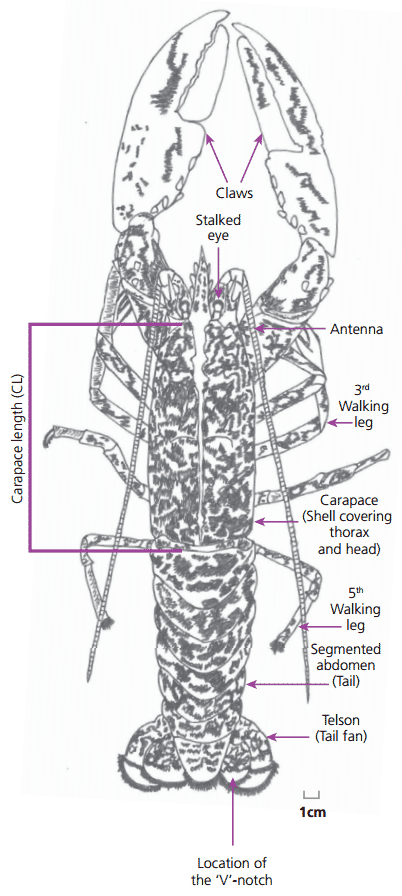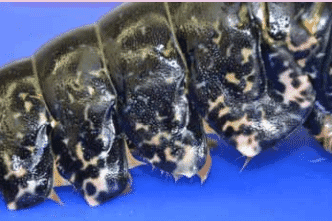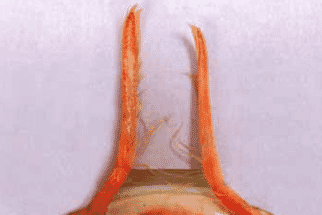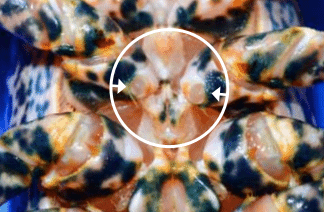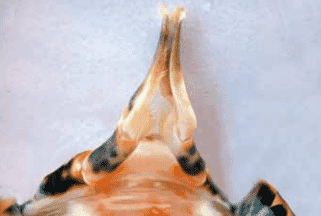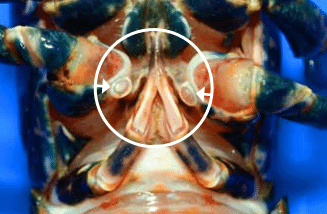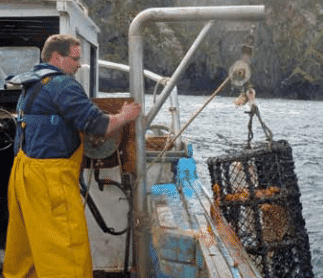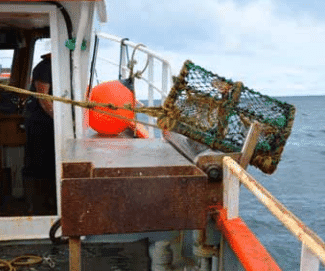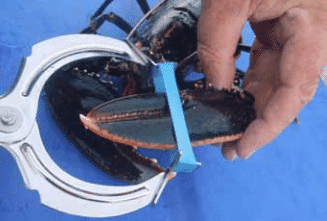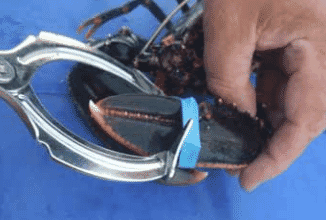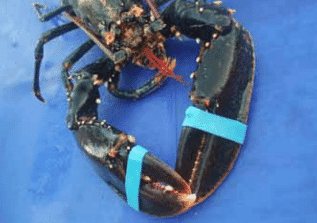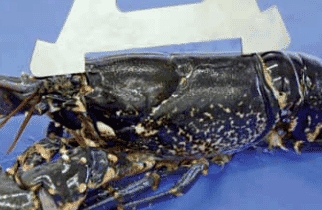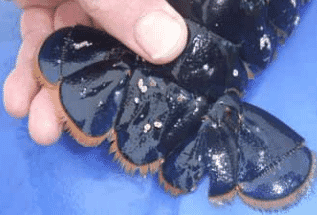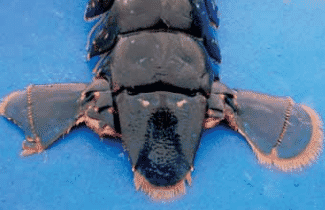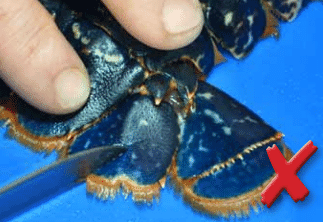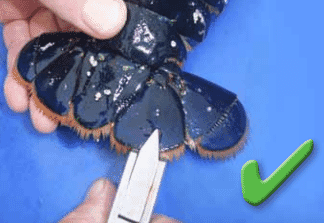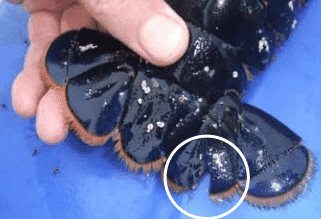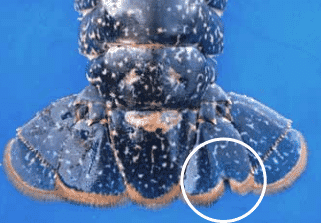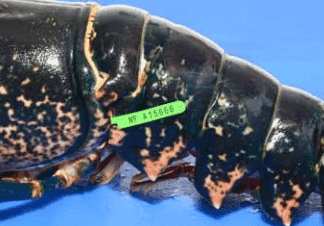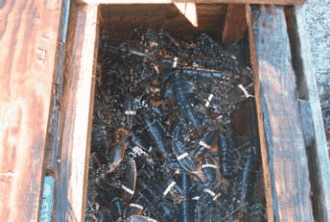The European lobster (Homarus gammarus) is dark blue with cream or yellow spots above, with the underside a more uniform yellow colour. Both sexes have two claws, one designed for crushing while the other is used for cutting.
Adult and juvenile lobsters are distributed from Norway in the north to the north African coast in the south and include the inshore waters of the North sea, the northern coast of the Mediterranean, Britain and Ireland.
Adult lobsters are mainly found throughout the coastal waters of the northeast Atlantic, on hard substrates particularly rough and rocky ground, which has crevices to provide shelter. They are found in depths down to 150m, but are most common between 20m and 60m.
Introduction
The fishery for lobster is one of the most traditional fisheries among coastal communities and the mainstay of many small vessels fishing all around the coast of Ireland.
Vessels range in length from 5m to 12m and include traditional currachs and naomhógs, open punts, modern fibre glass decked boats and catamarans.
The fishing season traditionally runs from late March to early October depending on fishing location and weather, but can take place all year round in sheltered bays.
Lobsters have traditionally been fished using pots or creels, which originally varied in shape and size from area to area around the coast. As time has gone by and lobster fishing has developed, a standard pot design has evolved which is D-shaped in section and made from steel rods covered in
netting and protected or “bumpered” with rope or rubber strips.
Two pot types are commonly used and are distinguished by their entrance configurations. Soft-eyed, side-entrance pots are the most common pot type used and are popular because they retain the catch for longer than other pot types.
Hard-eyed, top-entrance pots are popular in areas where there are different target species during the fishing season (e.g. lobsters, spider crabs, brown crabs).
These fishing methods have a low impact on the environment and are very selective, thereby greatly limiting the by-catch of other species.
The catch is sold live on export and domestic markets. The majority of the catch is exported to European markets mainly through France.
Age, Growth and Reproduction
Age and Life span
Lobsters can live for at least 20 years and possibly for up to 50 years. At the minimum landing size (MLS) of 87mm carapace length (CL) , lobsters are generally between 4 and 8 years old.
The minimum landing size measurement is taken from the rear of the eye socket to the rear edge of the carapace (i.e. Carapace length (CL); see morphology diagram). A size gauge is available from BIM to all fishermen to ensure that lobsters are at or above 87mm (CL) and no more than 127mm (CL).
Growth and Moulting
Lobsters grow in size by moulting or shedding their shell on a regular basis. The soft-shelled but larger lobster which emerges after each moult then hides until the new shell hardens. Moulting cannot occur when the female lobsters are carrying eggs, as the moulting process would cause the eggs to be lost.
Reproduction and Settlement
Mature female lobsters can carry up to 40,000 eggs depending upon their size and age, with the oldest and largest females carrying the most. Both males and females have feathery appendages called swimmerets, underneath their tail, which are used for swimming.
Swimmerets are also used by females to help secure fertilized eggs, which are carried, under the tail during their initial period of development.
The stage of development of the eggs is easily identified by their colour. The eggs are black when first laid and gradually change to light brown with a clearly visible black spot, known as an eye, to a bright orange, when the eggs are ready to hatch.
Hatching usually occurs between May and September with a peak in June and July depending on water temperature.
The hatched larvae spend 4 to 6 weeks in the water column before moulting into a final stage. They then start to seek out a suitable rocky bottom habitat to settle into and develop into juvenile lobsters.
Morphology
Handling Guidelines
Optimal handling and storage practices at sea and ashore are essential elements in the management of lobster quality and the achievement of maximum return on national and international markets.
- Make sure areas of the deck where lobsters are brought on board and stowed are kept clean;
- Remove lobsters from each pot carefully in order to avoid the loss of claws and legs, which may happen as a result of stress;
- Damage and bleeding can also affect a lobster’s ability to survive storage and transport;
- Place, rather than throw, lobsters into boxes or storage bins to prevent shell damage;
- Any undersized, oversized or ’V’-notched lobsters or those with mutilated tails must be returned to the sea immediately;
- Lobsters should be stored apart until they can be banded e.g. place in holding trays or in a box covered with porous, water absorbent cloth such as hessian sacking, which is kept damp;
- Ensure that new hessian sacking is well washed in clean seawater before use;
- Humidity should be kept high by covering the catch with porous, water absorbent cloth such as hessian sacking, which is periodically sprayed with seawater from a deck hose;
- Alternatively the catch may be covered with freshly picked wet seaweed over the top layer of the box;
- Allowing a deck hose to flow through boxes will keep the humidity high and will help to keep the temperature low.
- Boxes containing lobsters should be stored out of direct sunlight and protected from the wind and rain in order to keep the temperature as low as possible and prevent dehydration of the catch;
- Do not allow lobsters to sit in a tank of still water if at all possible, as the oxygen in the water will be quickly used up and toxic, waste byproducts will accumulate;
- Where possible, it is best practise to hold lobsters in a tank or bin fitted with a lid and arranged so that a deck hose can be channelled into the tank or bin, on one side, with the water draining from an outlet at deck level on the opposite side of the bin;
- To minimise claw loss due to banding, hold the lobster in one hand at the base of the claws while banding with the other hand;
- If the lobster is too large to hold in one hand, place the lobster on a solid surface while using both hands to complete the banding procedure;
- Recently moulted, soft-shelled lobsters are vulnerable to damage. For example, the shell may become dented due to excess pressure, when banding;
- Recently moulted lobsters should not be sold and should be held separately, in a pot, until their shells completely harden;
- When lobsters are held on deck they should be packed carefully, belly side down and legs tucked underneath and not on its back;
- Do not overfill boxes. A standard fish box should contain no more than 22kg of lobster (i.e. approximately 40 lobsters);
- Lobster keeps or storage boxes should be located in an area of good quality seawater with stable temperature and salinity;
- In some instances lobsters are tagged. Tagging should only be carried out by a competently trained person.
Identifying the Sexes
Female
The female, or hen, lobster’s abdomen is broader than that of the male in order to accommodate and protect the egg mass. The lower edge of each tail segment, beneath the abdomen, is smooth or blunt;
The first pair of swimmerets are soft and feathery;
The genital pores of female are located at the base of the third pair of legs.
Male
The male, or cock, lobster has a narrower abdomen than the female. The lower edge of each tail segment, beneath the abdomen, is pointed and sharp;
The first pair of swimmerets are hard and bony;
The genital pores of males are located at the base of the fifth pair of legs.
Hauling Methods
There are three common methods used to haul pots.
Punts, curraghs and small vessels under 5m generally hand-haul pots over the gunwale of the vessel.
Larger vessels use a hydraulic “slave” hauler to pull up the mainline but differ in the way the pots are brought on board.
A derrick and snatch block is most commonly used to bring pots on board but some vessels also use a roller to bring the pot over the gunwale and land it onto a stainless steel table.
Prevention of Damage to Claws and Legs
Care must be taken when hauling pots to prevent damage to claws and legs, which could decrease market value and leave lobsters more susceptible to disease and mortality.
- To avoid claw and leg damage, hauling should be stopped as the pot approaches the gunwale. The pot should be checked, re-positioned and shaken, as necessary, so that claws and legs are not protruding as the pot is brought on board.
Banding
Aggression between lobsters can account for limb loss and other physical damage. Lobster claws should be banded as soon as possible to prevent damage caused by aggression.
Lobsters should be banded as follows:
- A rubber band is placed on the banding pliers, which is then opened to stretch the band and placed over the widest part of the claw;
- The banding pliers is closed and removed leaving a tight fitting rubber band on the claw;
- This process is repeated until both claws are banded.
Rubber bands can perish due to UV degradation and should be stored in the dark; only have enough bands on deck to facilitate one day’s fishing.
Live Returns
Certain lobsters should not be landed and should be returned, alive and undamaged, to the sea. These are referred to as live returns and include the following:
- Lobsters that are below minimum landing size of 87mm (CL) and above the maximum legal landing size of 127mm (CL);
- When a lobster has a ‘V’-notch in its tail (See conservation and management), it is illegal to land, possess or sell it and it must be returned, alive, to the sea;
- It is also illegal to land any lobster with any visible damage to its tail (i.e. ‘mutilated tails’).
Conservation and Management
The ‘V’-notching of lobster tails is one of the most important technical conservation measures for the Irish lobster stock.
The practice was introduced to Ireland in the early 1990’s from Maine in the USA, where it is used in the American lobster fishery.
The technique was perfected by BIM in co-operation with the Shellfish Research Laboratory Carna, Údarás na Gaeltachta and the inshore fishing industry.
The aim of ‘V’-notching is to boost egg production and thus recruitment to the stock, by protecting a proportion of the female lobster population from fishing pressure.
BIM’s national ‘V’-notching programme is funded by the European Fisheries Fund (EFF) and the State. It is a voluntary partnership between BIM and lobster fishermen.
When a lobster is marked in this way, it is illegal to land, possess or sell it and it must be returned, alive, to the sea.
Lobster should be ‘V’-notched as follows:
- A stainless steel notching pliers, normally used for notching the ears of livestock, is used to make the ‘V’-notch;
- A small ‘V’-notch in one of the flaps on the tail of a female lobster is cut to create an easily recognized mark that remain two to three moults, which represents four to six years of growth;
- The flap at the centre of the lobster’s tail is avoided when ‘V’-notching, as this contains the gut ending and notching this flap can cause damage to the digestive tract of the lobster;
- Lobsters should be returned to the sea immediately as this stops any bleeding that may occur from the notching process.
It takes around four years for the ‘V’-notch to repair itself, as female lobsters generally breed and moult in alternate years. As such ‘V’-notching ensures that a female has an opportunity to breed at least once before the notch grows out. If a lobster is re-caught in this time it is generally re-notched and released. The process of ‘V’-notching does not unduly harm the lobster.
In some instances lobsters are tagged by trained persons. The tagging of lobsters is designed to find out more about the growth, distribution and seasonal patterns in abundance and size of lobster stocks. The recorded information should be forwarded to the local BIM representative.
Lobsters cannot be retained or captured by divers (i.e. SCUBA).
Lobster ‘V’-Notching
- When ‘V’-notching it is very important to use the correct notching pliers;
- A knife should not be used as it does not give as neat and quick a notch as the notching pliers;
- The second tail flap from the right is ‘V’-notched using a clean, stainless steel, notching pliers.
- A small notch is removed from the tail flap to create an easily recognised mark;
- The notch mark remains for two to three moults, which represents four to six years of growth;
- If a tagged lobster is caught, the tag number, carapace length (CL) and capture location of the lobster should be recorded and the lobster released immediately to the sea. The information collected should be dropped into the local BIM office.
Storage Prior to Sale
Holding lobsters at sea is a necessity in many cases as catches are not usually bought on a daily basis, given the logistics involved in transport and marketing.
- Lobsters are often stored in wooden, plastic or metal mesh keeps or storage boxes, which are stored at sea;
- It is recommended for lobster to be stored for no longer than 1 to 2 weeks prior to onward sale;
- When introducing new lobsters to the keep or storage box a visual inspection should be carried out for mortalities or damaged lobster already in storage;
- Local conditions (e.g. storm drains, outflows, freshwater run off) must be considered when choosing a site for keeps or storage boxes;
- Keeps or storage boxes should be suspended off the seabed, so that sand or mud cannot clog up the keep or storage box;
- Keeps or storage boxes should be located in an area of good quality seawater with stable temperature and salinity;
- Ensure keeps or storage boxes have adequate runners to ensure box is not directly touching the landing site.
July 2015

